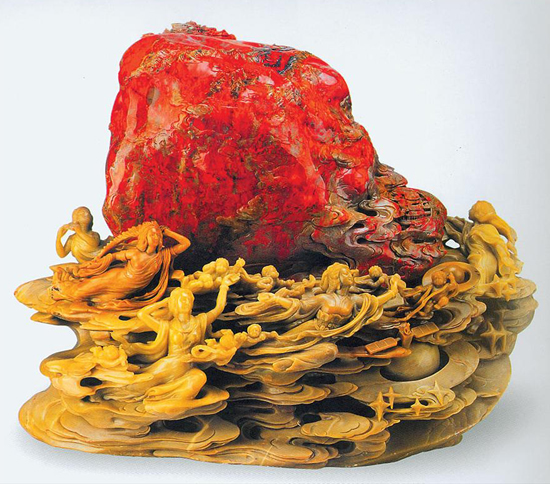 |
|
This crimson chicken-blood stone from Changhua, Zhejiang Province, placed over a carved wooden piece, costs several dozen million yuan.
|
Chicken blood stones are valuable in the gem trade due to their rarity and incredible beauty.
Chicken-blood stones are mined only in China and prized as an ornamental material used for seals and carvings.
The best stones are bright crimson, and the locals who first found them gave the name ji xue shi (鸡血石) because it appeared as though they had been splashed with the blood of a freshly slaughtered chicken.
The stones can only be found in Changhua Town near Hangzhou and Balin in Inner Mongolia autonomous region.
“Unlike other stones, you can’t display a chicken-blood stone otherwise it will lose the color,” says Wu Songlin, a gemstone collector. “So you just take it out to enjoy for a while and then put it back in the box immediately. But even for such a short time, it is satisfying.”
While known as chicken-blood stones around the world, they are actually soapstones. The only difference is the presence of cinnabar, a bright red mineral consisting of mercury sulfide.
A stone will appear more red if it has a higher content of cinnabar. The reddest stones are rarer, thus more expensive — prices can reach hundreds of million yuan for an uncarved stone — and prized by collectors.
The cinnabar in soapstones oxidizes easily in sunlight, thus even the richest red stones will darken or become black within half a year if they are not stored out of sunlight.
Red also symbolizes good luck in Chinese culture. The color has remained very popular from ancient days to modern times and is another reason why the stones have stayed so desirable.
“Among all the stones, I think Changhua chicken-blood stones boast the most beautiful color of red,” says Wu, who followed in his grandfather’s footsteps and started collecting gemstones as a child.
The stones can be used to make seals or sculptures although Wu prefers seals.
“Only the best chicken-blood stones can be selected for seals because there can’t be any crack on it and it still needs to have a beautiful pattern,” he says.
Cracked stones are best for sculptures since the sculptor can cover up the crack by carving that particular area of the stone.
We recommend:
